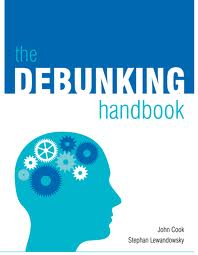 In the information Society, the possibilities of individuals to increase their knowledge are huge… but so are the possibilities of being manipulated, and consume information that are incorrect. These desinformaciones can become myths that we assume, in a way unthought-of. How to combat the myths, and how to make people be aware of their falsehood?
In the information Society, the possibilities of individuals to increase their knowledge are huge… but so are the possibilities of being manipulated, and consume information that are incorrect. These desinformaciones can become myths that we assume, in a way unthought-of. How to combat the myths, and how to make people be aware of their falsehood?
John Cook of the Global Change Institute (University of Queensland) and Stephan Lewandowsky of the School of Psychology of The University of Western Australia, have created The Debunking Handbook, a veritable guide of the demolition of myths.
The guide was published a couple of months ago, and I’ve finally been able to find a gap to offer a brief review. It has a total length of 9 pages: a reading is fast and agile, with very interesting ideas, and useful for communicators of different areas that they will confront the misinformation.
The first warning that we make to the authors is that the demolition of a myth is not a problem to provide more information. Rather, the problem has to do with the way in which we process the information. The influence of the desinformaciones in our beliefs may be noticeable, due to different cognitive biases or to the semantic nature of our memory. So, refute any misinformation has to do with complex cognitive phenomena, so that the process is more complex than we tend to think.
Then, what the most appropriate approach to demolish a myth? Cook and Lewandowsky offers us some principles that will support you in whatever you now know about the functioning of our cognition.
In the first place, it is generally believe that to demolish a myth, there is that mention it: what if you could not refute the misinformation? However, it happens just the opposite: to quote often the myth that it is intended to demolish makes you more present and available in the memory of the people, with what happens to be more familiar and more likely to be taken as true. This phenomenon is known as the familiarity back fire effect. How to avoid it?: put the emphasis on the facts, not the myth. Thus, the purpose of the communication must be the facts that we want the public to retain in his memory, those who disparage the misinformation, that you may be more familiar.
In the second place, we also tend to think that a few more counter-arguments we present to neutralize a misinformation, the better: more chance we will have of convincing the public of the falsehood of this. In fact, it is the contrary: the information simple are easier to process, and are judged as true more often. This is the known as the overkill back fire effect, by which a simple myth can be more attractive than a correction complex. The solution is to simplify the way in which the content is presented: for example, using simple language, short sentences, headings and appropriate paragraphs are well organized, or the use of graphics. In addition, it is a good idea to consider the inclusion of a final message simple powerful.
The themes that contradict the visions of the world or the cultural identity of the people are a major challenge. Different biases can lead to interpret the information in a manner that is clearly biased: faced with arguments to the contrary, we can strengthen the faith in our beliefs. This phenomenon is known as the worldview back fire effect. There are two strategies to combat it:
- Given that the effect is more marked in people who already have some ideological positions very marked, to demolish the myth it is convenient to directing efforts toward those who may remain in doubt about whether to believe or not to believe a particular piece of information.
- Present information in ways that reduce the resistance of cognitive, making use of strategies like self-affirmation or framed (framing).
Finally, we must consider a crucial step in the process of demolition. When the people we accept as true information, we create a mental model that tells us how the world works. When we show that this information is in reality a myth, a misinformation, what we have is a void (gap) in our model of the world. Therefore, not only is it necessary to submit the appropriate facts and the right way: in addition, we provide an alternative explanation that comes to fill that void. For that explanation to be accepted, it has to be plausible, and cover all relevant features of the myth. The explanation may be more effective if it is accompanied by an analysis of why the myth is wrong, or the hidden motives which may have specific people or groups of people in the dissemination of the myth. In addition, the effectiveness of the alternative explanation may be greater if you use graphics in your presentation, because they can be more clear than the text, and therefore more difficult to misinterpret.
The Debunking Handbook is not only a great little work by its content, easy to assimilate and very well informed, but in addition it is very well illustrated with graphs and summary tables. A reading is highly recommended.
